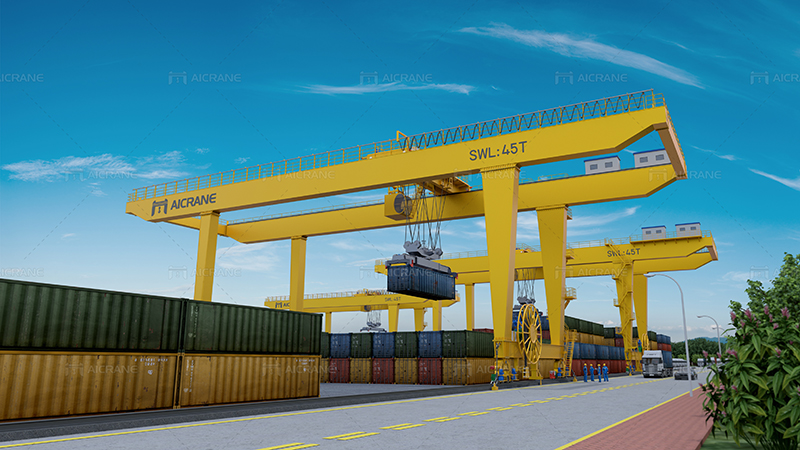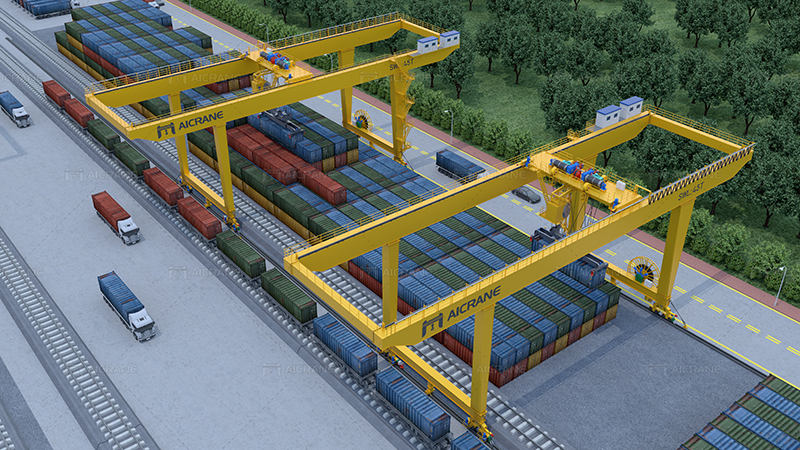In the world of material handling and logistics, rail-mounted gantry (RMG) cranes play a pivotal role in efficiently moving and managing heavy loads within industrial facilities and container terminals. These powerful machines are characterized by their ability to traverse on rails, providing stability and precision in lifting and transporting cargo. To understand the functionality and significance of rail-mounted gantry cranes, it is essential to delve into their key components.

Girder Structure
At the core of any rail-mounted gantry crane is its girder structure. This component forms the backbone of the rail mounted crane and is responsible for supporting the entire load during lifting and movement operations. The girder structure typically consists of steel beams that are carefully engineered to withstand the stresses and loads imposed on the crane during its operational life. The design of the girder structure directly influences the crane’s lifting capacity and overall stability.
Hoisting System
The hoisting system is another critical component of an RMG crane. This system includes the hoist mechanism, which is responsible for lifting and lowering the load. The hoist is usually equipped with a powerful motor, a drum or winch, and a set of cables or ropes. The design and capacity of the hoisting system determine the maximum weight that the crane can lift. Modern rail-mounted gantry cranes often feature advanced hoisting systems with variable frequency drives for precise control and enhanced energy efficiency.
Trolley and Traveling Mechanism
The trolley and traveling mechanism are integral parts of an RMG crane’s mobility. The trolley is responsible for horizontal movement along the crane’s girder structure, while the traveling mechanism allows the entire crane to traverse along the rail tracks. These components are crucial for positioning the crane accurately and efficiently in different areas of the facility. High-quality wheels, bearings, and drive systems ensure smooth and reliable movement, minimizing downtime and optimizing productivity.
Electrical and Control Systems
The electrical and control systems of a rail-mounted gantry crane are the brains behind its operation. These systems encompass a range of components, including programmable logic controllers (PLCs), sensors, and operator interfaces. The PLCs manage the crane’s various functions, such as lifting, lowering, trolley movement, and traveling along the rails. Safety features, such as collision avoidance systems and emergency stop mechanisms, are also integrated into the control systems to ensure the secure operation of the crane.

Power Supply System
Rail-mounted gantry cranes require a reliable power supply to operate efficiently. Depending on the specific requirements of the facility, these cranes may be powered by electricity or alternative sources such as diesel generators. The power supply system includes cables, conductors, and distribution panels that deliver power to the crane’s motors and control systems. Some advanced gantry cranes for container handling may incorporate regenerative braking systems, contributing to energy conservation and reducing overall operational costs.
Safety Features
Safety is paramount in the operation of rail-mounted gantry cranes, and several components contribute to ensuring a secure working environment. Anti-collision systems use sensors and advanced algorithms to prevent accidents and collisions between cranes or with other equipment in the vicinity. Overload protection mechanisms safeguard the crane from attempting lifts beyond its rated capacity, preventing potential damage to the crane and ensuring the safety of personnel and cargo.
Maintenance and Monitoring Systems
To prolong the life of a rail-mounted gantry crane and optimize its performance, maintenance and monitoring systems are essential. These systems may include predictive maintenance tools that use sensor data to anticipate potential issues before they lead to breakdowns. Remote monitoring capabilities allow operators to assess the crane’s status, track performance metrics, and schedule maintenance activities proactively. Regular inspections and lubrication routines are also part of the maintenance protocols to ensure the crane operates at peak efficiency.
Conclusion
Rail-mounted gantry cranes are indispensable in the realm of modern logistics and material handling, offering unparalleled efficiency and precision in lifting and transporting heavy loads. The integration of advanced components such as robust girder structures, powerful hoisting systems, sophisticated control systems, and comprehensive safety features makes these cranes vital assets for industries worldwide. As technology continues to evolve, rail-mounted gantry cranes are likely to undergo further enhancements, pushing the boundaries of their capabilities and contributing to the evolution of efficient and sustainable material handling solutions. To learn more about material lifting and handling equipment, visit https://steelmillcranes.com/